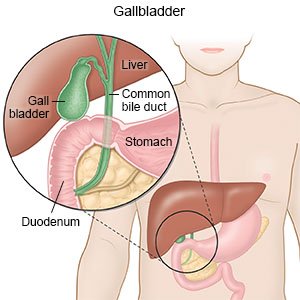Endoscopic Biliary Stent Placement
Medically reviewed by Drugs.com. Last updated on Aug 4, 2025.
AMBULATORY CARE:
What you need to know about an endoscopic biliary stent placement:
An endoscopic biliary stent placement is a procedure to open a blocked bile duct. Your bile duct carries bile from your gallbladder to your small intestine. Bile helps your body digest foods. A stent is a small tube made of plastic or metal. The stent helps widen your bile duct and keeps it open.
 |
How to prepare for an endoscopic biliary stent placement:
- Your healthcare provider will talk to you about how to prepare for your procedure. He or she may tell you not to eat or drink anything after midnight on the day of your procedure. He or she will tell you what medicines to take or not take on the day of your procedure. You may need to stop taking blood thinners, aspirin, or NSAIDs several days before your procedure.
- You may be given an antibiotic to help prevent a bacterial infection. You will be given contrast liquid during your procedure. Tell your healthcare provider if you have ever had an allergic reaction to contrast liquid or antibiotics. Arrange for someone to drive you home and stay with you.
What will happen during an endoscopic biliary stent placement:
- You will be given general anesthesia to keep you asleep and free from pain during surgery. Your healthcare provider will insert an endoscope through your mouth and into your stomach. An endoscope is a long tube with a camera and a light. The provider will move the endoscope until it reaches your small intestines. He or she will use the camera to find the opening to your bile duct.
- Your healthcare provider will inject contrast liquid into your bile duct. This will help your bile duct show up better in pictures. Your provider may use a balloon to widen your bile duct. He or she will insert 1 or more stents through the endoscope and into your bile duct. The provider will take more pictures to make sure the stent or stents are in the correct position.
What will happen after an endoscopic biliary stent placement:
Healthcare providers will monitor you until you are awake. You may need blood tests to check your liver function. You may have abdominal pain or feel bloated. You may also feel nauseous. These symptoms should go away in a few hours. You may be able to go home or you may need to spend a night in the hospital.
Risks of an endoscopic biliary stent placement:
You may bleed more than expected or get an infection. The endoscope or tools may damage your esophagus, stomach, intestines, or bile duct. The biliary stent may move out of place or block your bile duct. The procedure may not work and you may need to have another stent placed.
Related medications
Seek care immediately if:
- You have severe abdominal pain or your abdomen is larger than usual.
- You faint.
- You vomit blood or something that looks like coffee grounds.
- You have blood in your bowel movements, or your bowel movements look like tar.
- Your skin or whites of your eyes are yellow.
Contact your healthcare provider if:
- You have a fever or chills.
- You have nausea or are vomiting.
- Your skin is itchy, swollen, or you have a rash.
- You have questions or concerns about your condition or care.
Medicines:
- Medicines may be given to decrease pain.
- Take your medicine as directed. Contact your healthcare provider if you think your medicine is not helping or if you have side effects. Tell your provider if you are allergic to any medicine. Keep a list of the medicines, vitamins, and herbs you take. Include the amounts, and when and why you take them. Bring the list or the pill bottles to follow-up visits. Carry your medicine list with you in case of an emergency.
Self-care:
- Rest as directed. Return to your regular activities in 24 hours or as directed.
- Drink liquids as directed. Liquids will help flush the contrast liquid from your body. Ask how much liquid to drink each day and which liquids are best for you.
- Eat small meals more often. This may help prevent nausea. Do not eat spicy or greasy foods.
Follow up with your healthcare provider as directed:
You may need to return for more tests. Write down your questions so you remember to ask them during your visits.
© Copyright Merative 2025 Information is for End User's use only and may not be sold, redistributed or otherwise used for commercial purposes.
The above information is an educational aid only. It is not intended as medical advice for individual conditions or treatments. Talk to your doctor, nurse or pharmacist before following any medical regimen to see if it is safe and effective for you.
Further information
Always consult your healthcare provider to ensure the information displayed on this page applies to your personal circumstances.
